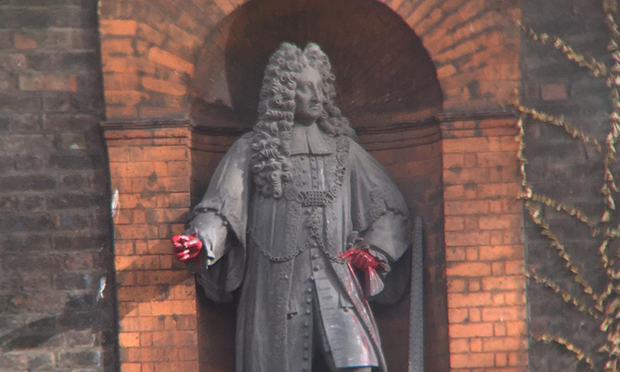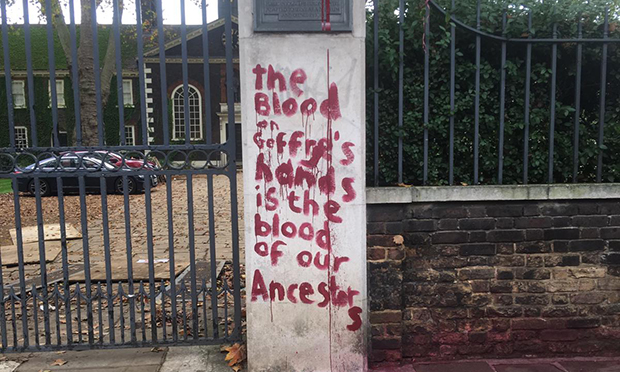Blood on his hands: Police investigate Robert Geffrye statue’s new paint job

Police are investigating after persons unknown appear to have jumped the fence at the Museum of the Home and, after scaling the front of the building, painted the hands of the statue of Robert Geffrye in red.
Red paint was also used at the gatepost to leave the message: “The blood on Geffrye’s hands is the blood of our ancestors.”
This references the controversy over the recent decision by the Museum’s board of trustees to retain the statue of slaver Geffrye in the face of a consultation showing a majority of people calling for its removal.
The Museum’s case has been the subject of scrutiny at parliamentary select committees after it was revealed that the institution came under pressure from the government to retain the statue of Geffrye, who made money from the enforced labour and trading of enslaved African people.
Community educator Toyin Agbetu of pan-African human rights organisation Ligali, a member of the community steering group taking part in the council’s ongoing review into the names of public space in the borough, said: “History shows us that direct action is often an inevitable outcome once all legitimate democratic processes have been exhausted to resolve social injustices.
“As an artistic intervention there is no doubt this creative reinterpretation has improved the aesthetics of the slaver Robert Geffrye’s statue. In making visible the history and human cost of those involved in such monstrous evil, the activists involved have committed a transgressive, yet progressive act of public service.
“Yet it is not enough, for although the innocuous plaque and replica statue that are now marred with fake blood have little monetary value, they continue to cause immense social harm and reputational damage to the museum and charity sector which I value greatly.”

The statue of Geffrye on the front of the Museum is a replica installed in1912 to replace the original, which was erected to commemorate Geffrye’s legacy in providing funds to build the almshouses for retired workers.
Geffrye was part-owner of the slave ship China Merchant, invested in the forced labour and trade of enslaved African people, and, according to the Museum, very likely derived the majority of his profits from his involvement in the East India Company and Royal African Company.
Hackney Stand Up To Racism campaigner Sasha Simic said that while none of his organisation’s members had taken part in the action, campaigners did not condemn the act, with Simic seeing the newly painted statue as a “great metaphor for the true history behind Geffrye”.
Simic said: “This shows the strength of feeling around the issue. This can’t be dismissed as just activists, this has a much bigger resonance with people. An overwhelming majority of people in the Museum’s own consultation on this statue wanted it to come down.
“When we petition to bring statues like this down, we are ignored. The statue of Edward Colston was argued over for years, and nothing happened. When it was brought down, more was known about Colston in the wake of that action than in the years beforehand.
“Direct action exposes this. They cannot criticise people for taking direct action if legal engagement brings nothing. When the trustees told the world they weren’t bringing the statue down after the consultation, they said they were talking with artists about how to present the statue in a way that brings out the deeper truths around Geffrye. It seems to me this is exactly what painting his hands red has done.”
When approached for comment, Hackney Mayor Philip Glanville said that while he did not condone the action, he understood the “sense of anger” behind it.
Of the 2,187 respondents to the consultation, 71 per cent voted to take the statue down, with 29 per cent saying to leave it up. Four per cent did not respond to the question.
The consultation also tracked how the statue made respondents feel, with three key themes finding that people thought it sent out “the wrong message” by celebrating and giving prominence to Geffrye; that there is “no place for it”, the statue is “not acceptable” and to remove it; and that the Museum’s benefactor “made money from others’ suffering [and that the statue] commemorates the slave trade”.
Freedom of Information requests recently revealed that the Museum came under pressure from culture secretary Oliver Dowden.
Mayor Glanville and the council’s equalities lead Cllr Carole Williams criticised Dowden for overreaching his role after correspondence showed the minister reminding the Museum of its status as a recipient of government funds.
The culture secretary’s intervention drew cross-party condemnation, with Caroline Russell, who leads the Green Party at City Hall, said: “It is very worrying to hear that a government minister is putting pressure on the curatorial team at the Museum of the Home over their decision about how to address the slaver past of Robert Geffrye whose statue stands outside the Museum.
“I hope the strong views of local people, expressed through the recent consultation, give the curatorial team confidence to tell the story about Robert Geffrye’s involvement in the forced labour and trade in enslaved African people and to place the statue in the best location for that story to be heard.
“It is right to face up to these difficult elements of our colonial past and to tell the raw stories behind the naming of streets, statues and buildings after slavers.”
Agbetu also called on the Museum to “seize this intervention as a chance to salvage some of its dwindling reputation” and remove the statue and its plaque.
He said: “As a cultural expression of local concerns, this evocative intervention should not be cleansed or quietly gentrified away.
“Considering the museum has, following consultation, a legitimate democratic mandate to both act on behalf of the community it serves and conserve symbols of culture and heritage, I would suggest that as a public institution, the staff and trustees take this opportunity to remove what is now a toxic, blood-stained statue and plaque, and place both in storage to preserve and one day exhibit this visual rhapsody of people power in 2020.”
Stand Up To Racism have said they plan a fourth demonstration as part of the Geffrye Must Fall campaign at the Museum’s gates on 30 October.
A spokesperson for the Museum said: “This weekend the Museum gates and the statue of Robert Geffrye were damaged. We are investigating what happened and have reported the damage to the police.
“The Board and Museum team are continuing to explore a number of options for the statue that are curatorially best suited to the Museum and our communities.”
The Metropolitan Police said: “Police are investigating following a report of criminal damage at a museum in Kingsland Road, E2.
“Officers received a report of a statue outside the museum being damaged at approximately 4am on Saturday 17 October.
“No arrests have been made and enquiries are ongoing.”
